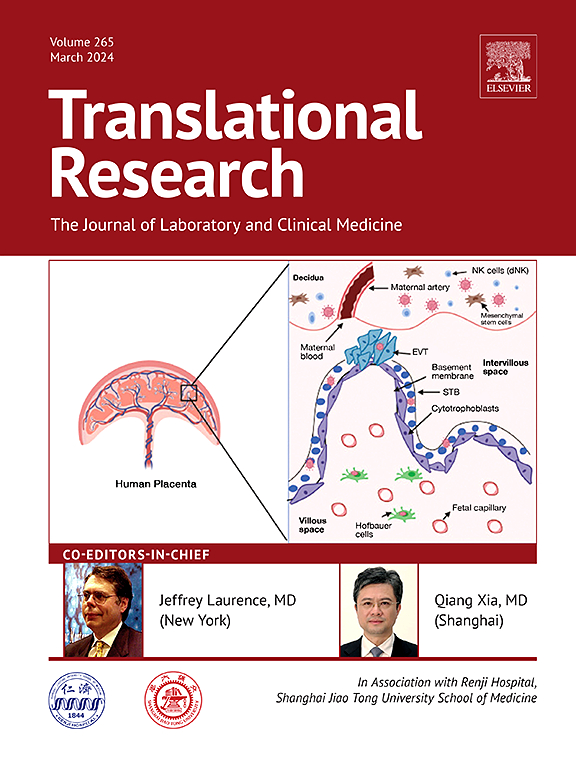Tailored CD4+ lymphocytes expressing human CHAT protein as a novel vasodilator in attenuating RV pressure in PAH animal model
IF 6.4
2区 医学
Q1 MEDICAL LABORATORY TECHNOLOGY
引用次数: 0
Abstract
ChAT-expressing T cells represent ∼0.01 % of total circulating T lymphocytes in adult wild-type mice. However, we previously reported that systemic infusion of ChAT+ve Jurkat T cells into adult mice elicits vasodilation and instantaneous decline in the mean systolic blood pressure, suggesting potential as a biologic therapeutic to attenuate pathologic increases in pulmonary arterial pressures. We now report that ChAT gene-expressing Jurkat cells dose-dependently decrease right ventricular systolic pressures (RVSP) in hypoxic mice and that transgenic mice with ChAT KO restricted to endothelial cells (KO END/ChAT-/-) exhibit significantly elevated pulmonary arterial pressure and peripheral systemic resistance (compared to WT mice). To rigorously characterize the role of CD4 ChAT+ T cells in regulating pulmonary arterial hypertension (PAH) hemodynamics and molecular signatures, we infused CD4+ ChAT+ve cells (0.5 to 2.0 million cells/animal) into adult PAH mice and noted significant reductions in RVSP within 2-3 min post injection (∼ 50 % reduction). The tailored tail vein injection effect was sustained until the animal was euthanized (30-40 min). Mice KO END/ChAT-/-showed a significant and severe hypoxia-induced PAH phenotype compared to WT adult mice. Tail vein injection of biologically active CD4 ChAT+ve cells into either KO END/ChAT-/-mice with hypoxia-induced PAH or into adult rats with hypoxia/Sugen-induced PAH resulted in significant attenuation of RVP elevations. RNA seq data analysis of human pulmonary endothelial cells (HPAECs) incubated with CD4 ChAT+ve T cells showed significant differential regulation of pathways involved in systemic and pulmonary pressure regulation, NO synthesis/regulation, antioxidant expression, and vasodilation. In conclusion, CD4 ChAT+ve T cells have a unique, vasodilating innate immunity mechanism to augment nitric oxide release and potentially mitigate molecular and genetic pathways involved in PAH pathogenesis.
表达人CHAT蛋白的定制CD4+淋巴细胞作为一种新型血管扩张剂在PAH动物模型中减弱RV压力。
在成年野生型小鼠中,表达chat的T细胞占循环T淋巴细胞总量的0.01%。然而,我们之前报道过,将ChAT+ve Jurkat T细胞全身输注成年小鼠可引起血管舒张和平均收缩压的瞬时下降,这表明它有可能作为一种生物疗法来减轻病理性肺动脉压升高。我们现在报道,表达ChAT基因的Jurkat细胞剂量依赖性地降低了缺氧小鼠的右心室收缩压(RVSP),并且与WT小鼠相比,限制内皮细胞(KO END/ChAT-/-)的ChAT- KO转基因小鼠表现出显著升高的肺动脉压和外周全身抵抗。为了严格表征CD4 ChAT+ T细胞在调节肺动脉高压(PAH)血流动力学和分子特征中的作用,我们将CD4+ ChAT+ T细胞(50万至200万个细胞/只动物)注入成年PAH小鼠,并在注射后2-3分钟内发现RVSP显著降低(约50%)。量身定制的尾静脉注射效果持续到动物安乐死(30-40分钟)。与WT成年小鼠相比,小鼠KO END/ChAT-/-表现出明显且严重的缺氧诱导的PAH表型。将具有生物活性的CD4 ChAT+ve细胞尾静脉注射到缺氧诱导PAH的KO END/ChAT-/-小鼠或缺氧/糖诱导PAH的成年大鼠中,RVP升高显著降低。对人肺内皮细胞(HPAECs)与CD4 ChAT+ve T细胞孵育的RNA seq数据分析显示,参与全身和肺压力调节、NO合成/调节、抗氧化表达和血管舒张的途径存在显著差异。总之,CD4 ChAT+ve T细胞具有独特的血管舒张先天免疫机制,可以增加一氧化氮的释放,并可能减轻参与PAH发病的分子和遗传途径。
本文章由计算机程序翻译,如有差异,请以英文原文为准。
求助全文
约1分钟内获得全文
求助全文
来源期刊

Translational Research
医学-医学:内科
CiteScore
15.70
自引率
0.00%
发文量
195
审稿时长
14 days
期刊介绍:
Translational Research (formerly The Journal of Laboratory and Clinical Medicine) delivers original investigations in the broad fields of laboratory, clinical, and public health research. Published monthly since 1915, it keeps readers up-to-date on significant biomedical research from all subspecialties of medicine.
 求助内容:
求助内容: 应助结果提醒方式:
应助结果提醒方式:


